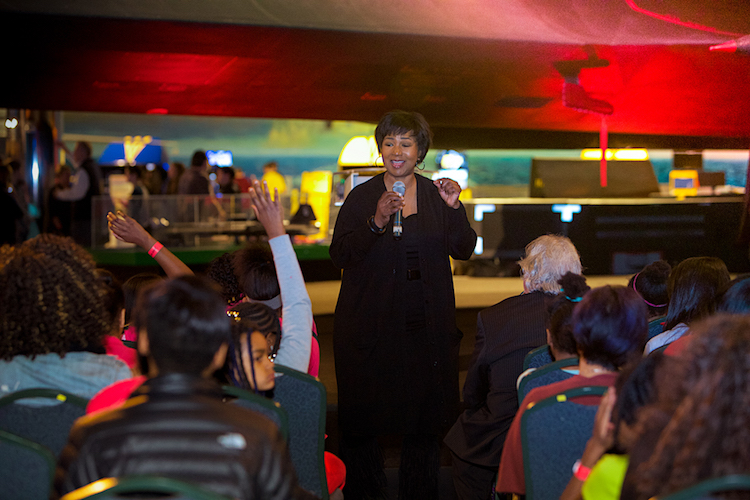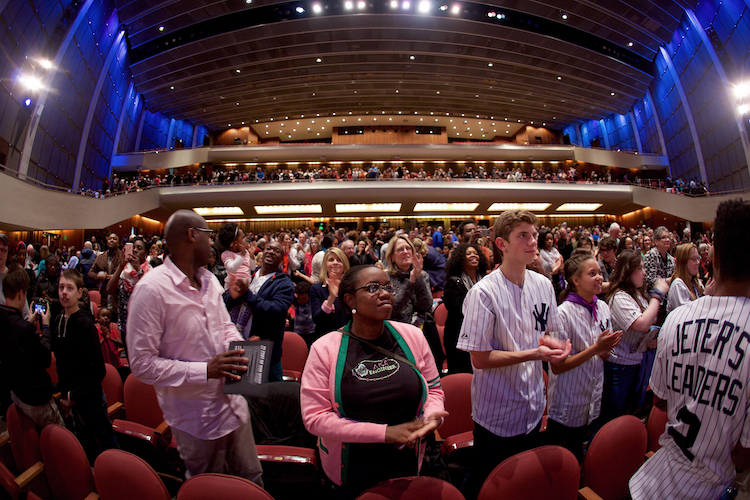First black woman in space asks crowd to dream of interstellar travel and save Earth in the process
Space travel is not just for rocket scientists and billionaires, says Dr. Mae Jemison, the first African American woman in space.
Mae Jemison’s middle name is Carol. But it could easily be Extraordinary.
The first African American woman in space has lived a life that is the stuff of books and movies. Growing up on the South Side of Chicago with a love of both dance and science. Teachers and parents who encouraged her to pursue both. College at age 16. A degree in 1977 in chemical engineering earned while she simultaneously pursued African and Afro-American studies. A doctorate in medicine four years later. Work as an engineer and in a Cambodian refugee camp. Scientist on the space shuttle Endeavour where she logged 190 hours, 30 minutes, and 23 seconds in space. And a one-time appearance on Star Trek.
The Kalamazoo Community Foundation asked Jemison to speak at its 2017 community meeting because she exemplifies a life in which education became a pathway for her to reach all that she aspired to do despite the obstacles of racism and sexism that she faced as she pursued her career. Her life encompasses education and equity, the cornerstones of the Foundation’s work.
And based on her appearance in Kalamazoo you could say that inspiration is Jemison’s mission. In a talk sprinkled with humor and quotations of black thought leaders, her theme throughout the community meeting packed with school age girls and boys was the pursuit of the extraordinary and how we each must bring our own unique perspective to that pursuit.
When she dreams it is no small dream. One of her current projects is 100 Year Star Ship. It is born of the idea that humans need to push themselves to accomplishments that can only be attained collaboratively and which are therefore greater than any individual could achieve.
100 Year Star Ship was begun to tackle the science and myriad other complex matters from clothing to governance that go into sending people to the stars. The project is dedicated to identifying and pushing the radical leaps in knowledge and technology needed to achieve interstellar flight. Those working on the project expect the pioneering and transforming breakthrough applications that make it possible to reach the stars will enhance the quality of life for all on Earth.
Just as the NASA space missions brought about technology that we find indispensable today — GPS, weather satellites, and miniaturization, to name a few — 100 Year Star Ship is expected to foster technology that can improve life now.
“We are on a starship right now with limited resources,” Jemison says. “We have to create a plan for our future.” The perspectives of people with many kinds of backgrounds will be needed in order to identify the best solutions.
Getting a place at the table is only the first step, Jemison told the full-house at Miller Auditorium. After that, it’s about bringing your perspective to bear once you are there. “What difference does it make if you have a place at the table and you act like everyone else and mind your table manners?”
For example, as the first African American female astronaut, she brought her perspectives as a woman who grew up in Chicago in the 1960s. (“I was not old enough to be a hippy.”) “That time was all about exploring. Everywhere you looked people were breaking speed records. … There was limitless potential in the world.” It was also a time of the 1969 riots and she feared for her father’s life when he left for work in the morning.

Her perspective is also shaped by her love of both dance and science. “Why do we choose one or the other? We need both sides of our brain to reach a solution.” (She later quipped that the decision between dance and medicine was made for her by her mother who encouraged her to consider that she could not learn to be a doctor without med school, but after med school, she could still dance.)
Perspective makes a difference when it comes to finding the best path forward, she says. An engineer’s perspective determines what data sets get analyzed, what technology is targeted for development, what topics are to be researched. The lack of diversity in engineering, where there are few women and racial minorities, means “one-third of the perspectives available are being lost.”
She says that as an avid fan of the original Star Trek television show, she always assumed she would go into space one day. She credited her success in part to the support of two particular teachers, one who challenged her and one who came in before school to provide the advanced instruction she and another student needed to be competitive in college.
She was not equally encouraged at the university level, however. One professor questioned her presence in his class. Subsequently, a study by the Bayer Corp. has shown that women tend to drop out of science and engineering programs in college because they are discouraged by their professors, Jemison notes. “Women drop out more rapidly than men because professors don’t treat them as colleagues or allies.”
During a question and answer session led by WMUK’s Earlene McMichael, Jemison was asked how to interest young people in Science, Technology, Engineering and Mathematics (STEM) fields.
“Kids are naturally curious. It’s adults who demotivate them. Adults stifle them with our fears. When we teach science as rote memorization it becomes boring. When kids do hands-on work that’s when they learn. You learn about electricity by wiring a flashlight. Let them ask why.”
Jemison has boiled down what motivates youngsters to learn to three E’s: experience, expectations (children live up or down to our expectations), and exposure (being exposed to the sciences).
She cautioned her audience to forget the platitude that you can do anything you want. “I did not get a part in West Side Story because I can’t sing.” What can lead to success is developing deep skills and expertise and not allowing others to define who you are.
Jemison meets with students
In addition to her address before the community, Jemison met March 24 with about 40 students, ages, 9 to 13, in a Q&A session in which she talked about her experiences as a student, a woman of color, and as a scientist. Students questions ranged from those of technical curiosity (how long does it take to get to space) to the personal (what was your first job and how did you prepare for your future).
After the Q&A session students toured the Air Zoo to learn about the different aircraft there and take in some aerospace history. They also learned of scholarships available for those who want to participate in Air Zoo science programs.
The students from the YWCA’s TechGyrls program, the Merze Tate Explorers, and Eastside Youth Strong split into groups to talk about what they had learned during the day and some reflected on what it might take to overcome obstacles and persist through personal and academic difficulties.
The program encouraging STEM learning was made possible by The Learning Network of Greater Kalamazoo and the Air Zoo.
The 2017 Community Meeting was part of the University Center for the Humanities at Western Michigan University’s 2016-2017 speaker series: Science and the Human Endeavor.
Kathy Jennings is the managing editor of Southwest Michigan’s Second Wave. She is a freelance writer and editor.
Photos by Terry Johnston




















